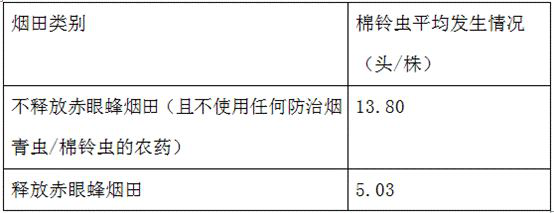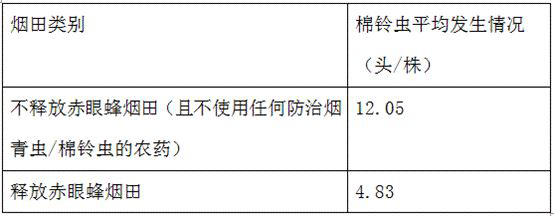Insect prevention method for tobacco leaves
A technology for preventing insects and tobacco leaves, which is applied in the field of tobacco pest control, can solve the problems of ecological environment destruction of tobacco fields, aggravated pollution of the environment, and influence on the quality of tobacco leaves, etc., and achieves the effects of improving the effect of pest control, reducing environmental pollution, and reducing pesticide residues.
- Summary
- Abstract
- Description
- Claims
- Application Information
AI Technical Summary
Problems solved by technology
Method used
Image
Examples
Embodiment 1
[0031] Tobacco leaf insect control methods include: using Aphidia nicola to control aphids, spraying nutrient solution, using Liphid wasp to control whitefly, using Trichogramma to control tobacco budworm / cotton bollworm, using stink bugs to control tobacco budworm / cotton bollworm, insect control post-processing.
[0032] 1. Control aphids with the use of Aphids persicae: After the tobacco seedlings were transplanted at the end of April of that year, small sheds for beekeeping were built in the field. For bees, 70 bees are released every day, and the number of bees released is 700 per mu continuously for 10 days.
[0033] In 2020, Weifang Zhucheng Tobacco Area will promote the application of Aphids aphids to control Aphids 97,500 mu, with a coverage rate of 100%. According to the results of field bee release surveys, the average biological control effect in tobacco fields reached 76.4%, and the application of chemical pesticides for aphid control was reduced by 100%.
[0034...
Embodiment 2
[0057] Tobacco leaf insect control methods include: using Aphidia nicola to control aphids, spraying nutrient solution, using Liphid wasp to control whitefly, using Trichogramma to control tobacco budworm / cotton bollworm, using stink bugs to control tobacco budworm / cotton bollworm, insect control post-processing.
[0058] 1. Control aphids by using Aphids aphidica: after the tobacco seedlings were transplanted at the end of April of that year, small beekeeping sheds were built in the field, and the number of bee sheds was set up for every 310 mu, and the bee release was carried out continuously. For bees, 72 bees are released every day for 11 consecutive days, and the number of bees released per mu is 720.
[0059] In 2019, Weifang Zhucheng Tobacco Area promoted the application of Aphids tabaci to control Aphids aphids to 105,000 mu, with a coverage rate of 100%. According to the results of field bee release surveys, the average biological control effect in tobacco fields rea...
Embodiment 3
[0083] Tobacco leaf insect control methods include: using Aphidia nicola to control aphids, spraying nutrient solution, using Liphid wasp to control whitefly, using Trichogramma to control tobacco budworm / cotton bollworm, using stink bugs to control tobacco budworm / cotton bollworm, insect control post-processing.
[0084] 1. Control aphids with the use of Aphids aphidatidis: After the tobacco seedlings were transplanted at the end of April of that year, small beekeeping sheds were built in the field, and the number of bee sheds was set up for every 320 mu. For bees, 75 bees are released every day, and the number of bees released is 900 per mu continuously for 12 days.
[0085] In 2021, the Weifang Tobacco Area will promote the application of Aphis persicae to control and control Aphids persica to reach 100,000 mu, with a coverage rate of 100%. According to the results of field bee release surveys, the average biological control effect in tobacco fields reached 79.31%, and the...
PUM
 Login to View More
Login to View More Abstract
Description
Claims
Application Information
 Login to View More
Login to View More - R&D Engineer
- R&D Manager
- IP Professional
- Industry Leading Data Capabilities
- Powerful AI technology
- Patent DNA Extraction
Browse by: Latest US Patents, China's latest patents, Technical Efficacy Thesaurus, Application Domain, Technology Topic, Popular Technical Reports.
© 2024 PatSnap. All rights reserved.Legal|Privacy policy|Modern Slavery Act Transparency Statement|Sitemap|About US| Contact US: help@patsnap.com










